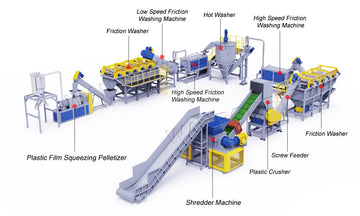In the realm of plastic waste recycling, plastic film—often used in packaging, grocery bags, and agricultural coverings—presents unique challenges. Due to its lightweight nature and complex material composition, traditional recycling methods may not be sufficient. This is where plastic film washing recycling systems play a crucial role. These systems are specifically designed to handle, clean, and process plastic films, transforming them into reusable material that contributes to a circular economy.
What is a Plastic Film Washing Recycling System?
A plastic film washing recycling system is a sophisticated setup used to clean, separate, and process plastic film waste into high-quality plastic flakes or pellets, which can be used in manufacturing new products. The process involves a series of steps to remove contaminants such as dirt, adhesives, labels, and other residues that often stick to plastic films.
Importance of Plastic Film Recycling
- Environmental Benefits: Plastic film waste is notoriously difficult to manage, contributing to the growing issue of plastic pollution in landfills and oceans. Recycling plastic film not only reduces the amount of waste but also helps conserve resources by reducing the need for virgin plastic production.
- Cost Savings for Industries: Industries using plastic films, such as packaging and agriculture, can significantly reduce costs by recycling their waste. Instead of paying for waste disposal, these industries can recycle their plastic film and use it in new production cycles.
- Resource Efficiency: Recycling plastic film minimizes the energy and resources needed to produce new plastic materials. The process reduces the carbon footprint associated with the extraction of raw materials and plastic manufacturing.
Steps Involved in a Plastic Film Washing Recycling System
- Pre-shredding: The plastic films are first shredded into smaller pieces, allowing for more efficient cleaning. This step is critical to ensure that large, tangled films are reduced to a manageable size for further processing.
- Pre-washing: In this phase, the plastic film is subjected to a preliminary wash, which removes surface dirt and some of the larger contaminants.
- Friction Washing: The shredded plastic is vigorously scrubbed in a friction washer, where high-speed rotating paddles help dislodge dirt, oils, and labels. This step is crucial for ensuring the cleanliness of the plastic before further separation.
- Sink-Float Separation: This process uses water to separate materials based on density. Since most contaminants and non-plastic elements sink while the clean plastic film floats, it becomes easier to isolate the plastic for recycling.
- Hot Washing: The hot washing process uses heated water and sometimes detergents to remove glue, oil, and other stubborn contaminants from the plastic film.
- Drying and Air Classification: The clean plastic film is dried using mechanical and thermal methods. Air classification systems may also be used to remove any remaining lightweight contaminants.
- Final Shredding and Extrusion: After drying, the plastic film is further shredded into uniform sizes and extruded into plastic flakes or pellets, which can be used as raw materials in the production of new plastic items.
Key Benefits of a Plastic Film Washing Recycling System
- High Output Quality: The multi-step washing process ensures that the resulting plastic is of high purity and can be reused in various manufacturing processes. Clean, recycled plastic is in demand across industries like packaging, construction, and textiles.
- Customizable Process: Recycling systems can be tailored to meet specific material requirements, depending on the type of plastic film being processed (e.g., LDPE, HDPE, or multi-layer films).
- Reduction of Waste Contamination: One of the most significant challenges in plastic film recycling is contamination from labels, adhesives, and food residue. The thorough washing process ensures that these contaminants are effectively removed, improving the quality and usability of recycled material.
- Energy and Resource Efficiency: Modern plastic film washing systems are designed with energy efficiency in mind. By using advanced filtration and water recycling technologies, these systems reduce water and energy consumption while delivering high-quality recycled materials.
Applications of Recycled Plastic Film
- Packaging: Recycled plastic film can be used in the production of new packaging materials, such as plastic bags, wraps, and pouches.
- Agriculture: Cleaned and recycled plastic film is used in agricultural applications like greenhouse covers, mulch films, and irrigation systems.
- Construction: Recycled plastic pellets are incorporated into building materials, such as pipes, insulation, and panels.
- Textile Industry: Some recycled plastic films can be transformed into synthetic fibers for textiles used in clothing and upholstery.
Plastic film washing recycling systems offer a viable solution to the growing plastic waste problem, ensuring that valuable materials are not lost to landfills. By effectively cleaning and processing plastic film waste, these systems provide industries with high-quality recycled material, reduce the environmental impact of plastic waste, and support the global push toward sustainable practices.
For businesses and municipalities, investing in a plastic film washing recycling system not only contributes to environmental sustainability but also offers economic benefits in terms of reduced waste management costs and access to reusable materials. Embracing such technology is a key step toward building a greener, more sustainable future.

